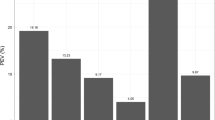Abstract
The method of Characteristic Scores and Scales (CSS), previously developed for application at the macro- and meso-level, has been applied to individual author statistics. In particular, two datasets have been used. Firstly, authors with Thomson Reuters Researcher-ID, independently of the field where authors are publishing and, secondly, authors who are active in the field of scientometrics, independently whether they are registered authors or not. The objective is to find a parameter-free solution for citation-impact assessment at this level of aggregation that is insensitive to possible outliers. As in the case of any statistics, the only limitation is the lower bound, which has been set to 10 for the present analysis. The results demonstrate the usefulness of the CSS method at this level while also pointing to some remarkable statistical properties.



Similar content being viewed by others
References
Abdulhayoglu, M.A. & Thijs, B. (2016). Leveraging researchgate for the purpose of author name disambiguation. GTM2016: 6th Global Techmining Conference. Valencia, Spain.
Albarrán, P., & Ruiz-Castillo, J. (2011). References made and citations received by scientific articles. Journal of the Association for Information Science and Technology, 62(1), 40–49.
Glänzel, W. (2007). Characteristic scores and scales. A bibliometric analysis of subject characteristics based on long-term citation observation. Journal of Informetrics, 1(1), 92–102.
Glänzel, W. (2013). High-end performance or outlier? Evaluating the tail of scientometric distribution. Scientometrics, 97(1), 13–23.
Glänzel, W., & Schubert, A. (1988). Characteristic scores and scales in assessing citation impact. Journal of Information Science, 14(2), 123–127.
Glänzel, W., & Schubert, A. (2003). A new classification scheme of science fields and subfields designed for scientometric evaluation purposes. Scientometrics, 56(3), 357–367.
Glänzel, W., Schubert, A., Thijs, B., & Debackere, K. (2009). Subfield-specific normalized relative indicators and a new generation of relational charts: Methodological foundations illustrated on the assessment of institutional research performance. Scientometrics, 78(1), 165–188.
Glänzel, W., Thijs, B., & Debackere, K. (2014). The application of citation-based performance classes to the disciplinary and multidisciplinary assessment in national comparison and institutional research assessment. Scientometrics. doi:10.1007/s11192-014-1247-1. (in press).
Heeffer, S., Thijs, B., & Glänzel, W. (2013). Are registered authors more productive? ISSI Newsletter, 9(2), 29–32.
Leydesdorff, L., Bornmann, L., Mutz, R., & Opthof, T. (2011). Turning the tables on citation analysis one more time: Principles for comparing sets of documents. Journal of the Association for Information Science and Technology, 62(7), 1370–1381.
Thijs, B., Debackere, K., Glänzel, W. (2014), Improved author profiling through the use of citation classes. In: Ed Noyons (Ed.), Proceedings of the science and technology indicators conference 2014 Leiden, “Context Counts: Pathways to Master Big and Little Data”, held on 3–5 September 2014 in Leiden, the Netherlands, University Leiden, 616–622.
Wildgaard, L. (2016). A critical analysis of 44 indicators of author-level performance. Journal on Informetrics, 10(4), 1055–1078.
Wildgaard, L., Schneider, J. W., & Larsen, B. (2014). A review of the characteristics of 108 author-level biliometric indicators. Scientometrics, 101(1), 125–158.
Acknowledgement
The present study is an extended version of an article presented at the Proceedings of the Science and Technology Indicators Conference 2014 Leiden, 3–5 September 2014 (Thijs et al. 2014). We would like to thank the anonymous reviewers at different stages of this study for their valuable suggestions and remarks.
Author information
Authors and Affiliations
Corresponding author
About this article
Cite this article
Thijs, B., Debackere, K. & Glänzel, W. Improved author profiling through the use of citation classes. Scientometrics 111, 829–839 (2017). https://doi.org/10.1007/s11192-017-2282-5
Received:
Published:
Issue Date:
DOI: https://doi.org/10.1007/s11192-017-2282-5




